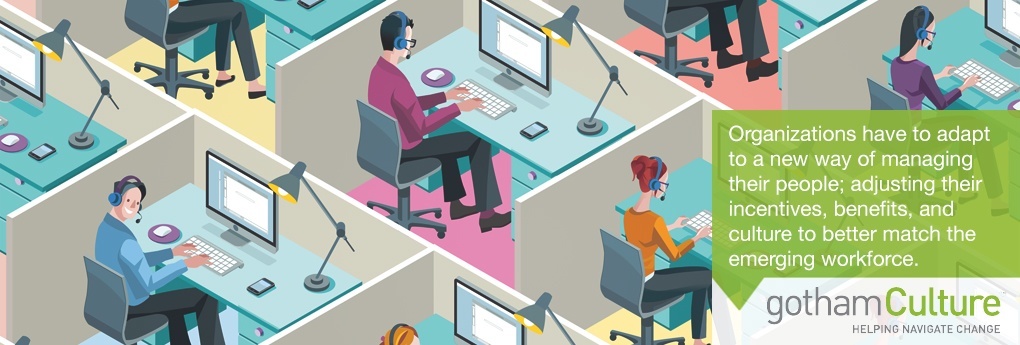Multi-Generational
Why Employee Retention Should Focus On More Than Millennials
By gothamCulture

Most organizations still regard Millennials as somehow different than their Gen X or Boomer co-workers, but do these assumed differences really hold any weight in the workplace? Or are these stereotypes merely a byproduct of a business environment that looks starkly different than it did 20 years ago?
A surprising study from IBM sheds some light on the truth: Millennials, Gen X, and Boomers all share very similar opinions of the workplace.
The New Guard: How to Develop and Retain Millennial Leaders
By gothamCulture

It’s happened: Millennials (by most definitions, those born between 1980 and the late 1990s) are now the largest generation in the U.S. workforce. And they’re no longer the generation waiting in the wings to become leaders—they’re already increasingly entering senior and managerial positions.
Along with this influx of young managers comes a shift in the role of manager itself. Managers are no longer only focused on making sure work gets done, but also on how and why it gets done. They are expected to be detail-oriented and strategic, to build culture and ensure productivity. And their position is also pivotal for employee engagement: A recent Gallup poll found that managers accounted for 70% of variance in employee engagement.
Employee Retention: When Achieving True Success Means Letting Go
By gothamCulture

The war for talent. The age-old battle waged by HR teams across the country, each vying to secure and retain the best people to help them achieve organizational success. The eternal effort to create systems, process, and benefits to help keep them once you’ve recruited them.
At the epicenter of the war for talent resides the tech industry, where many talented engineers and other highly-skilled workers have no problem jumping to another employer for a minor bump in pay or benefits. The result? Companies are forever trying to outshine each other with baubles, beer kegs and nap pods to try to entice this demographic to join them.
What this approach fails to do is inspire loyalty. Despite all the money that these companies pour into perks, at the end of the day, it’s just job hopping.
Engaging Gen Y: Employees Are Thinking Far Beyond The Cubicle
By gothamCulture

The Business Manager at my last employer just celebrated her 43-year work anniversary. At 20 years old, she took an administrative job and worked her way up over the next 40 years as she gained more experience and tenure. It was her first job and she will be working there until she retires 2 years from now.
Stories like this used to be more common in the workplace. It was commonplace to get a job on the ground floor of a company, expecting that they will take care of you and your professional career while you grow with them. You were expected to work your way up the ladder to a middle management position, then the corner office; all the while building your pension so you can finally escape the cubicle on your 65th birthday.
Organizational Culture, Talent Management and Onboarding Across the Generational Divide
By gothamCulture
Recent articles such as “Silicon Valley’s Youth Problem” and “The Brutal Ageism of Tech” highlight and reinforce the importance of adhering to some crucial tenets when thinking about organizational culture and onboarding across the generational divide.
1. Your organization’s culture will impact what kind of talent you attract.
Policies for employees are a critical part of your organizational culture, or “the way we do things around here.” For example, guidelines like a minimum vacation allowance rather than a maximum limit, the frequency and energy at organizational happy hours, and the expectations around working hours might attract younger employees. Conversely, policies such as paternity leave, stock options, retirement contributions and a set 9-5 schedule will likely attract an older demographic.
2. This culture you created and the talent you attracted will also impact how you onboard them. If the culture values innovation, trial and error and is moving quickly, and then the onboarding process might involve some shadowing of a colleague, personalized coaching and meeting with some more tenured colleagues for learning about a deeper sense of organizational mission, history, and values. However, if the culture values structure, hierarchical process, consistency and might be in a less of a hurry, a more formal, standardized onboarding process could be necessary to make sure that the new employee will be perform consistently and with clear expectations.
It’s crucial to remember that no culture is necessarily “better” or “worse” nor is there a “better” or “worse” approach to talent management or training. What is critical, however, is to ensure that your organizational culture and onboarding is intentionally designed in such a way to attract and train the talent you need to be successful as an organization. This alignment between culture and talent and training is one often overlooked piece of the puzzle in achieving your organization’s mission and well worth a close look.
